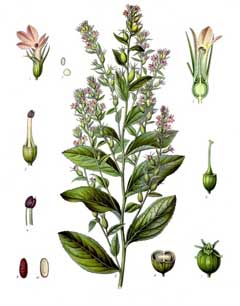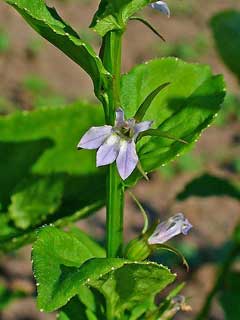 |
|
http://commons.wikimedia.org/wiki/File:Koeh-218.jpg |
 |
| http://commons.wikimedia.org/wiki/User:Llez |
Translate this page:
Summary
Physical Characteristics

 Lobelia inflata is a ANNUAL growing to 0.6 m (2ft) by 0.3 m (1ft in). It is in flower from July to August, and the seeds ripen from August to September. The species is hermaphrodite (has both male and female organs). The plant is self-fertile.
Lobelia inflata is a ANNUAL growing to 0.6 m (2ft) by 0.3 m (1ft in). It is in flower from July to August, and the seeds ripen from August to September. The species is hermaphrodite (has both male and female organs). The plant is self-fertile.
Suitable for: light (sandy), medium (loamy) and heavy (clay) soils and can grow in heavy clay soil. Suitable pH: mildly acid, neutral and basic (mildly alkaline) soils. It can grow in semi-shade (light woodland) or no shade. It prefers moist soil.
UK Hardiness Map
US Hardiness Map
Synonyms
Dortmannia inflata. Lobelia michauxii. Rapuntium inflatum. Rapuntium michauxii
Plant Habitats
Cultivated Beds;
Edible Uses
References More on Edible Uses
Medicinal Uses
Plants For A Future can not take any responsibility for any adverse effects from the use of plants. Always seek advice from a professional before using a plant medicinally.
Antiasthmatic Antispasmodic Diaphoretic Diuretic Emetic Expectorant Miscellany Nervine
Indian Tobacco was a traditional North American Indian remedy for a wide range of conditions[254]. Nowadays it is used mainly as a powerful antispasmodic herb in the treatment of respiratory and muscle disorders[254]. Acting also as a respiratory stimulant, Indian Tobacco is a valuable remedy for conditions such as bronchial asthma and chronic bronchitis[254]. The dried flowering herb and the seed are antiasthmatic, antispasmodic, diaphoretic, diuretic, emetic, expectorant and nervine[4, 7, 21, 46, 165, 171]. The plant is taken internally in the treatment of asthma, bronchitis, whooping cough and pleurisy[238]. This remedy should be used with great caution and only under the supervision of a qualified practitioner[7, 21, 165]. Excess doses cause nausea, vomiting, drowsiness and respiratory failure[238]. See also the notes above on toxicity. The plant contains the alkaline 'lobeline' which has proved to be of value in helping people to give up smoking tobacco[7, 200, 213]. It is contained in many proprietary anti-smoking mixtures where it mimics the effects of nicotine[238]. The alkaloids present in the leaves are used to stimulate the removal of phlegm from the respiratory tract[213]. When chewed, the leaves induce vomiting, headache and nausea - in larger doses it has caused death[213]. The alkaloids first act as a stimulant and then as a depressive to the autonomic nervous system and in high doses paralyses muscular action in the same way as curare[213]. Externally, the plant is used in treating pleurisy, rheumatism, tennis elbow, whiplash injuries, boils and ulcers[238]. The whole plant is harvested when the lower fruits are ripe and it is used fresh or dried[238].
References More on Medicinal Uses
The Bookshop: Edible Plant Books
Our Latest books on Perennial Plants For Food Forests and Permaculture Gardens in paperback or digital formats.

Edible Tropical Plants
Food Forest Plants for Hotter Conditions: 250+ Plants For Tropical Food Forests & Permaculture Gardens.
More

Edible Temperate Plants
Plants for Your Food Forest: 500 Plants for Temperate Food Forests & Permaculture Gardens.
More

More Books
PFAF have eight books available in paperback and digital formats. Browse the shop for more information.
Shop Now
Other Uses
References More on Other Uses
Cultivation details
Succeeds in full sun or light shade[200]. Grows well in heavy clay soils. Prefers a slightly acid soil[238]. Plants are usually annual, but are sometimes biennial[4]. This species is occasionally cultivated commercially as a medicinal plant[46, 57].
References Carbon Farming Information and Carbon Sequestration Information
Temperature Converter
Type a value in the Celsius field to convert the value to Fahrenheit:
Fahrenheit:
The PFAF Bookshop
Plants For A Future have a number of books available in paperback and digital form. Book titles include Edible Plants, Edible Perennials, Edible Trees,Edible Shrubs, Woodland Gardening, and Temperate Food Forest Plants. Our new book is Food Forest Plants For Hotter Conditions (Tropical and Sub-Tropical).
Shop Now
Plant Propagation
Seed - sow spring or autumn in situ. The seed usually germinates within 2 weeks.
Other Names
If available other names are mentioned here
Native Range
NORTHERN AMERICA: Canada (Québec (south), Nova Scotia, Ontario (southeast), Prince Edward Island, New Brunswick), United States (Connecticut, Indiana, Maine, Massachusetts, Michigan, New Hampshire, New Jersey, New York, Ohio, Pennsylvania, Rhode Island, Vermont, West Virginia, Iowa, Kansas (east), Minnesota, Missouri, Nebraska (east), Illinois, Wisconsin, Alabama, Arkansas, Delaware, Georgia, Kentucky, Maryland, Mississippi, North Carolina, South Carolina, Tennessee, Virginia)
Weed Potential
Right plant wrong place. We are currently updating this section.
Please note that a plant may be invasive in one area but may not in your area so it's worth checking.
Conservation Status
IUCN Red List of Threatened Plants Status :

Growth: S = slow M = medium F = fast. Soil: L = light (sandy) M = medium H = heavy (clay). pH: A = acid N = neutral B = basic (alkaline). Shade: F = full shade S = semi-shade N = no shade. Moisture: D = dry M = Moist We = wet Wa = water.
Now available:
Food Forest Plants for Mediterranean Conditions
350+ Perennial Plants For Mediterranean and Drier Food Forests and Permaculture Gardens.
[Paperback and eBook]
This is the third in Plants For A Future's series of plant guides for food forests tailored to
specific climate zones. Following volumes on temperate and tropical ecosystems, this book focuses
on species suited to Mediterranean conditions—regions with hot, dry summers and cool, wet winters,
often facing the added challenge of climate change.
Read More
Expert comment
Author
L.
Botanical References
43200
Links / References
For a list of references used on this page please go here
Readers comment